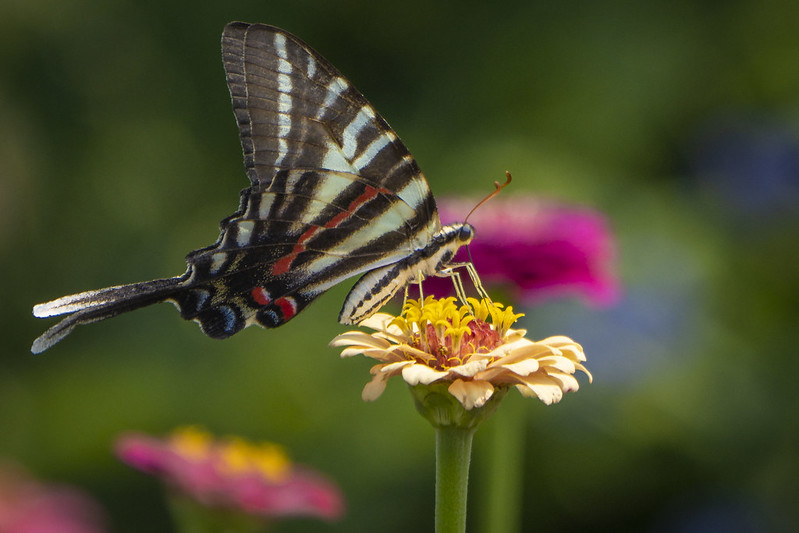Protecting Pollinator Health
ARS promotes sustainable crop production by protecting crops and pollinators from pests that threaten their health and consequently reduce crop yields. Modern cropping systems may play a significant role in reduced populations of pollinators and other beneficial insects. ARS researchers across the country are evaluating the ecology, distribution, conservation, and effectiveness of insect predators, pollinators, and other beneficial insects. Researchers are quantifying the impact of agricultural management practices on insect populations and their activities and quantifying the services that beneficial insects provide to crop productivity, including pollination. The following accomplishments in 2021 highlight several ARS advances in pollinator health and pest management research.
Flowers as hubs for the microbial symbionts of bees. Native bees are important for cranberry pollination and the role of floral substrates as the ‘hub’ of microbial transmission among native bee fauna has been a focus of investigation by researchers. The survival of native bees depends on microbial symbionts within the pollen provision. Microbes are critical to the development of bee larvae, but the various mechanisms and key factors for this relationship have not been explored. ARS scientists in Madison, Wisconsin, showed that flowers serve as the pick-up and drop-off sites for beneficial bacteria and yeasts. Microbial communities pre-digest the pollen grains within the larva’s pollen provision. These symbiont microbes function much like those within the rumen of a cow, providing access to amino acids and lipids that would otherwise be unavailable to young developing bees. ARS scientists showed that these microbial communities are not specific to certain bee species, but rather are shared widely throughout bee species. The mechanisms of transmission are mediated by flowers in the landscape and ensure that critical microbial groups are harbored long enough to be broadly distributed among pollinator populations. This work is critically important for agriculture because pollinators are essential to fruit set and development.
New methods to protect managed solitary bees from parasites. Solitary bees, including alfalfa leafcutting and bumble bees, are important pollinators. Alfalfa leafcutting bees are crucial to pollination for seed production, whereas bumble bees are used to pollinate greenhouse crops such as tomato. Alfalfa leafcutting bees need to be incubated prior to adult emergence, but parasitic wasps can destroy the entire population, and, bumble bee species are plagued by parasitic cuckoo bumble bees, which steal nest resources. ARS scientists in Logan, Utah, found that adding a dichlorvos insecticide strip at 3 days into incubation of alfalfa leafcutting bees killed several species of parasitic wasps. This treatment was much earlier than previously recommended and did not harm alfalfa leafcutting bees. For bumble bees, a fabricated excluder was designed to prevent cuckoo bumble bee invasion and was 100 percent effective at reducing bumble bee colony loss. Using these tools can help ensure effective delivery of alfalfa leafcutting bee and bumble bee pollination services.
Natural compounds combat against major viral diseases in honeybees. There are currently no registered treatments or medicines that are effective against honeybee viruses and other microbes. Natural products that range from extracts of secondary compounds in plants and other living organisms to organic molecules provide a rich source of candidates for bee disease treatment. ARS scientists in Beltsville, Maryland, developed efficient and inexpensive screening techniques for testing new natural medicines for bees. Researchers discovered and patented several natural product compounds that are effective hive-based treatments against major bee viruses. These efforts expand the available options for beekeepers to control diseases, and help ensure better colony health, pollination services, and the production of honey and other hive products.
Nutrients in seasonal pollens support the annual cycle of honeybee colonies. Colony losses from malnutrition could be reduced by providing pollen sources that meet the annual nutritional needs of honeybees. ARS researchers in Tucson, Arizona, identified the nutrients in spring and fall pollen and bee responses to them. Pollens were collected in Arizona and Iowa where seasonal cycles of colony growth are similar in spring and summer but differ in the fall and winter. In Iowa, brood rearing is followed by cold temperatures, leading to months of confinement in the hive. Spring pollens from Arizona and Iowa had higher levels of nutrients that support brood rearing, and bees consuming spring pollens developed larger brood food glands for feeding the queen and rearing larvae. Fall pollen from Iowa had higher levels of fatty acids and certain amino acids needed to support colonies during confinement. These findings are important for developing pollinator seed mixtures that provide pollen with required nutrients throughout the period when colonies are active, and in the formulation of pollen substitute diets that need to be specific for the season when they are being fed to colonies.
 Keres, Preston. A Swallowtail butterfly visits Goldpetal Farms in Chaptico, Md., July 17, 2021. USDA Photo. https://flic.kr/p/2mc1ouQ
Keres, Preston. A Swallowtail butterfly visits Goldpetal Farms in Chaptico, Md., July 17, 2021. USDA Photo. https://flic.kr/p/2mc1ouQ

